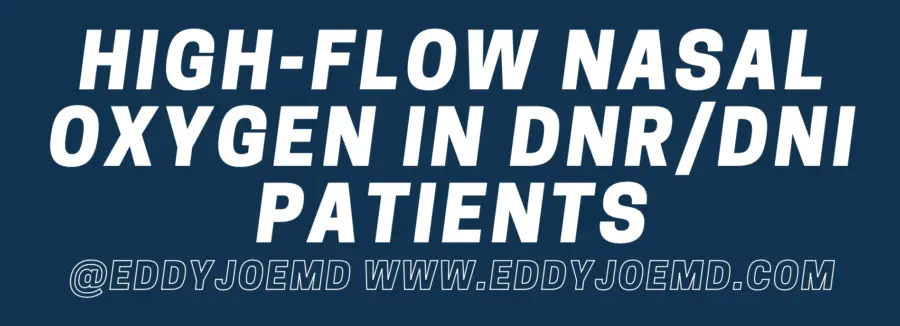This topic is very dear to me because I am a huuuuuuuge proponent for appropriate end of life care. I’m an Intensivist after all and people unfortunately die on my service. We all are going to have our day. My goal with the patients I take care of is to make their passing to the next life as comfortable as possible with as much love surrounding the individual as humanly possible. It irks me at times when clinicians write patients off and do not want to apply high flow nasal cannula (HFNC, NFH, HFO) just because they have a DNR/DNI order written.
For the non-medical people around here that means do not resuscitate/do not intubate. Also, what are you doing around here? Those patients also need our best efforts as they are already cognizant of their impending mortality. That usually means their friends and family members are also aware and would rather be around when the inevitable to all of us occurs and they pass. In this article, the authors attempted to avoid utilizing non-invasive ventilation, or as most of us just call it, BiPAP/CPAP, by placing patients on high flow nasal cannula.
What data do we have on High Flow in DNR Patients?
Small study by Peters et al., 50 patients. Can you imagine the difficulty in enrolling patients into a study like this? It must have been quite challenging. In short, although mortality in hospital was appropriately high, they found that they were able to avoid placing patients on BiPAP in 82% of patients. To me, this is particularly important because that means these patients were able to comfort eat, speak to their families, say their goodbyes, give them unobstructed hugs (due to the BiPAP mask), kisses, and smiles without a NIV mask in the way.
The decreased RR as a clinician to me is significant because if there’s one thing that makes me uncomfortable, it’s a patient who is in frank respiratory distress sucking wind to survive. A respiratory rate decrease from 30.6 to 24.7 is something I’d take any day. This is something I do in my practice. I was very happy to run into their article and find some data to support what I anecdotally believed. CLICK HERE for more content on HFNC. It is applicable to use high flow in patients who are DNR/DNI statuses.
Citation for High Flow in DNR/DNI
Peters SG, Holets SR, Gay PC. High-flow nasal cannula therapy in do-not-intubate patients with hypoxemic respiratory distress. Respir Care. 2013 Apr;58(4):597-600. doi: 10.4187/respcare.01887. PMID: 22781059.
Link to Article
Link to FULL FREE PDF
Ruangsomboon O, Dorongthom T, Chakorn T, Monsomboon A, Praphruetkit N, Limsuwat C, Surabenjawong U, Riyapan S, Nakornchai T, Chaisirin W. High-Flow Nasal Cannula Versus Conventional Oxygen Therapy in Relieving Dyspnea in Emergency Palliative Patients With Do-Not-Intubate Status: A Randomized Crossover Study. Ann Emerg Med. 2020 May;75(5):615-626. doi: 10.1016/j.annemergmed.2019.09.009. Epub 2019 Dec 19. PMID: 31864728.
Link to Article
Link to FULL FREE PDF
How To Support My Work
My efforts are at no cost to you and I would like to keep it that way. You have to look at ads on this website, listen to them on my podcast and YouTube content. Thanks for bearing with me. You could also support my work by clicking on my Amazon Affiliate links prior to ordering things off of Amazon.
For example, if you want to learn more about Mechanical Ventilation, I recommend starting off with The Ventilator Book by Will Owens. If you click on that link, a window for Amazon will open up and I will earn between a 1-3% commission at no expense to you. The fun thing is that if you order anything else on Amazon, I will earn that amount off of your shopping cart even if you do not purchase the book. Pretty cool, right? In 2020, Amazon Affiliates helped me pay for the hosting of my website, LLC fees, and Netflix.
Although great care has been taken to ensure that the information in this post is accurate, eddyjoemd, LLC shall not be held responsible or in any way liable for the continued accuracy of the information, or for any errors, omissions or inaccuracies, or for any consequences arising therefrom.
